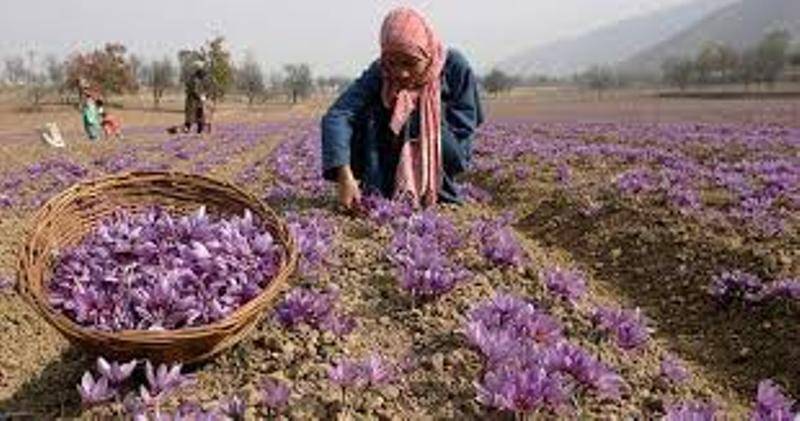
Pulwama, Budgam, Kishtwar and Srinagar districts of Kashmir Region is always in headlines due to extremist’s activities but this time the news is for Kashmiri Saffron that got GI Tag. Kashmir saffron is renowned globally as a spice. It rejuvenates health and is used in cosmetics and for medicinal purposes. It has been associated with traditional Kashmiri cuisine and represents the rich cultural heritage of the region. The unique characteristics of Kashmir saffron are its longer and thicker stigmas, natural deep-red colour, high aroma, bitter flavour, chemical-free processing, and high quantity of crocin (colouring strength), safranal (flavour) and picrocrocin (bitterness). Saffron cultivation is believed to have been introduced in Kashmir by Central Asian immigrants around 1st Century BCE. In ancient Sanskrit literature, saffron is referred to as ‘bahukam’.
It is the only saffron in the world grown at an altitude of 1,600 m to 1,800 m AMSL (above mean sea level), which adds to its uniqueness and differentiates it from other saffron varieties available the world over.
Kashmir saffron, which is cultivated and harvested in the Karewa (highlands) of Jammu and Kashmir, has been given the Geographical Indication (GI) tag by the Geographical Indications Registry. The spice is grown in some regions of Kashmir, including Pulwama, Budgam, Kishtwar and Srinagar.
In September 2019, Kashmir’s saffron farmers met with officials of the Geographical Indications Registry in New Delhi, a meeting facilitated by the Kashmir department of agriculture. Deputy registrar Chinnaraja G Naidu sought details of the method of production, area under cultivation and reasons for GI tagging.

India is the fourth largest importer of Iranian saffron: In 2018, it imported saffron worth $18.30 million from Iran, according to the Trade Promotion Council of India. Iran is currently the largest producer of saffron in the world, as we said earlier, cultivating over 300 tonnes every year on 30,000 hectares of land. In Kashmir, which ranks second in supply, saffron cultivation is limited to about one-eighth that area--3,715 hectares.
Pampore, the township in Pulwama district with around 3,200 hectares of land under saffron cultivation, produces the most in the Valley, according to the agriculture department. Srinagar and Budgam cultivate saffron on 165 and 300 hectares, respectively; Kishtwar is the only district in the Jammu division to grow the spice on 50 hectares of land.
The price of Kashmiri saffron fell by 48% after 2007, the year Iranian imports grew substantially, as per the All J&K Saffron Growers Development Cooperative Marketing Association. A gram of Kashmiri saffron fetched Rs 120 in 2020, against Rs 250 in 2007, said Abdul Majeed Wani, a saffron grower and President of the Association.
Chinnaraja G. Naidu, Deputy Registrar of Geographical Indications, said, “Kashmir saffron is a very precious and costly product. Iran is the largest producer of saffron and India is a close competitor. With the GI tag, Kashmir saffron would gain more prominence in the export market,” he added.
The saffron available in Kashmir is of three types — ‘Lachha Saffron’, with stigmas just separated from the flowers and dried without further processing; ‘Mongra Saffron’, in which stigmas are detached from the flower, dried in the sun and processed traditionally; and ‘Guchhi Saffron’, which is the same as Lachha, except that the latter’s dried stigmas are packed loosely in air-tight containers while the former has stigmas joined together in a bundle tied with a cloth thread.















